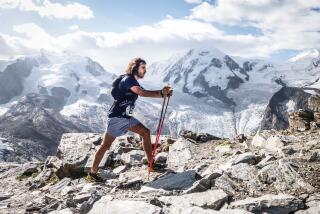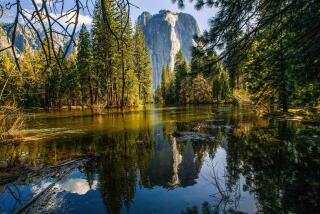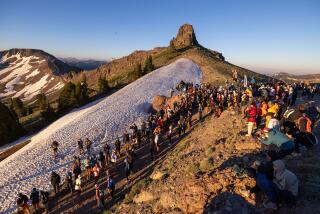On the Beaten Path : Barry Hawley swears by joys and benefits of off-road dirt courses. He’s organizing four county runs to share his convictions.
Barry Hawley is a gregarious English expatriate who would like to sell you on the idea that running on dirt trails--at distances up to 100 miles--is not only fun, but it might even be good for you.
Hawley (“Baz” to his friends) has been organizing the San Juan Trail 50 each year since 1984. The November race leaves from Blue Jay Campground off Ortega Highway, in the Santa Ana Mountains above San Juan Capistrano, and winds 50 miles along the trails of the Cleveland National Forest. One of the premier events in the sport of ultra-running, the run has attracted more than 200 competitors in some years.
Hoping to enlighten more runners to the joys of running off-road, Hawley has come up with a four-run series along some of the same trails. Realizing that most runners, even marathoners, can’t jump up and run 50 miles, Hawley will start off the series Feb. 13 with a 12-kilometer run and gradually increase the distances until the series closes with a 50K on March 27. That’s 31 miles, the start of the “ultra” distance class.
“I’m trying to build up the distance so that after two months, you might be willing to try the ultra distance,” Hawley said. But it is OK if you just want to try one or more of the shorter distances, he added.
Hawley was a veteran of more than 100 marathons when he tried his first ultra run in 1984--the Western States 100, granddaddy of ultra events, which started in the mid-’70s. Since then, he has run in four 100-mile events and numerous 50-milers. In addition to organizing to the San Juan Trail 50, Hawley runs the annual Shadow of the Giants 50K in Fish Camp near Yosemite, where he owns a bed and breakfast, and the annual Mule Run Ultra 50K in Bishop.
An engineer by profession, Hawley bought his B&B; in 1989 and moved there from a home in San Clemente, returning each year to put on his San Juan Trail run. To run in winter in Fish Camp often meant following the snow plows. This year, he decided he’d had enough of the cold and decided to close his doors for a few months and head for the beach, staying in a house right on the sand in Capistrano Beach.
A true convert to off-road running, Hawley is quick to extol the virtues it holds over running on streets. “You’re going back to the basics when you run off-road . . . . It’s closer to the raw, nitty-gritty of running,” he said. With road running, he added, “There’s no diversity. It’s just flat.”
Most road runners tend to hit their peak and plateau in their performance level after five to seven years, Hawley said, while off-road running is a continuing evolution. And, he added, runners can stay competitive at more advanced ages--the average age of male runners is about 43, he said. And female runners do well, also. Anne Trason’s finish in a recent Western States 100 would have placed her third among the men, an unheard-of finish in road races.
“I’m so competitive at 50 miles, I’m beating some of these young” runners, said Hawley, 51, in an English accent tinged with Aussie bluster (he lived in Australia for 12 years). “Being able to beat someone half my age-- that’s an ego boost.”
Hawley is anticipating 60 to 100 runners for each event in his Winter Trail Run Series (he declines to call them races, preferring to keep them somewhat introductory and informal in nature). He hopes to make the series an annual event, and was encouraged when he attracted a sponsor (Avia shoes), a rarity for off-road events.
He has several words of advice for runners who want to try one of the off-road events for the first time. First, carry a bottle of water. The longer races in the series will also have aid stations along the route. “You must be well-hydrated when you run on the trails,” Hawley warned.
On trails, he said, “you’re going to be running slower, because of the terrain.” Also, he added, “your energy will be drained faster” than it is running on the street. Hawley suggested that anyone interested in the sport head to a local park and try running on a dirt path, just for practice. Passing another runner on a narrow path can prove tricky, too.
Hawley insists that the sport is easier on the body than road running, partly because runners aren’t going as fast (because of the terrain) and because the surface is softer, resulting in less jolting to the joints. Despite popular perceptions, Hawley said there are not an inordinate number of ankle sprains or other injuries caused by uneven terrain, mostly because runners take extra care with their footing on trails.
Also, most runners walk the steepest or most treacherous stretches. “You don’t lose points for walking,” he said.
Part of the allure of running off-road is overcoming challenges unique to the sport, Hawley said.
“One day you’re going to be running along the trail and you’re going to find yourself looking up at this hill a quarter-mile high,” Hawley said. “The first time, you might walk it. The next time, you might run up half and walk the rest. One day, you’re going to run it all.”
*
The Winter Trail Run Series is held at between 2,000- and 4,000-feet elevation in the Cleveland National Forest. All runs start and finish at Blue Jay Campground. To reach the site, take Ortega Highway north from Interstate 5 for about 15 miles to El Cariso Village, and turn left at the turnoff for Falcon and Blue Jay campgrounds.
There is no race day registration for any of the events. To register, contact Hawley by phone, or pick up an entry blank in sporting goods stores. His number is (714) 248-8899.
Feb. 13 is the date of the 12K; Feb. 27 is the date of the 22K. The entry fee for each run is $18. A 36K run will be held March 6 (entry fee is $25). The 50K will be held March 27 (entry fee is $43). Start times are 8 a.m. for the first three runs, 7 a.m. for the 50K.
More to Read
Sign up for The Wild
We’ll help you find the best places to hike, bike and run, as well as the perfect silent spots for meditation and yoga.
You may occasionally receive promotional content from the Los Angeles Times.






